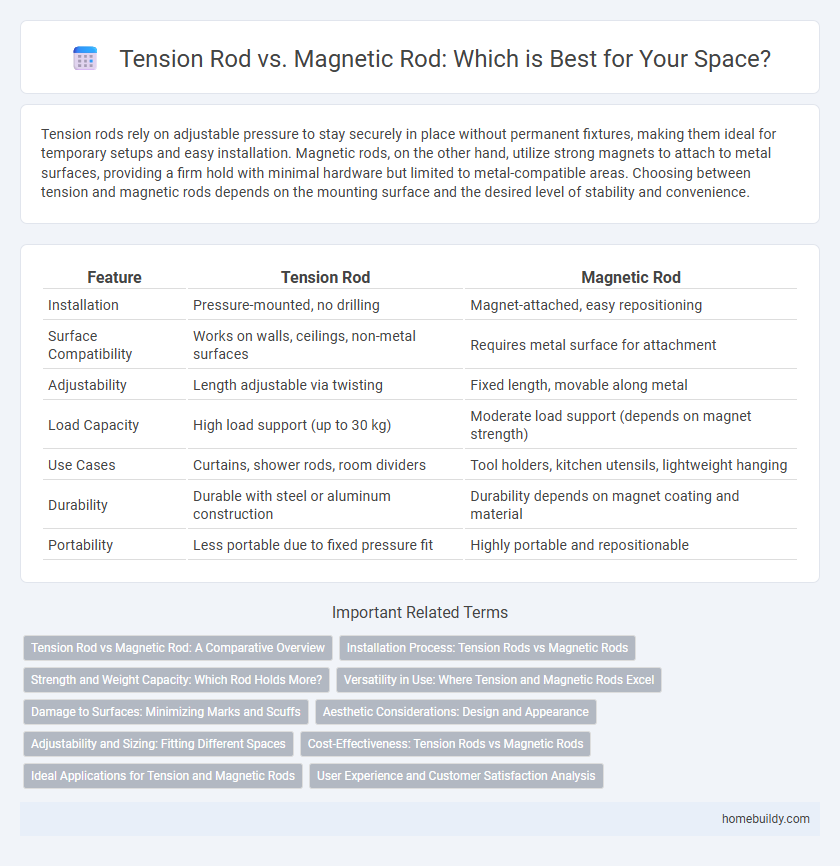Tension rods rely on adjustable pressure to stay securely in place without permanent fixtures, making them ideal for temporary setups and easy installation. Magnetic rods, on the other hand, utilize strong magnets to attach to metal surfaces, providing a firm hold with minimal hardware but limited to metal-compatible areas. Choosing between tension and magnetic rods depends on the mounting surface and the desired level of stability and convenience.
Table of Comparison
| Feature | Tension Rod | Magnetic Rod |
|---|---|---|
| Installation | Pressure-mounted, no drilling | Magnet-attached, easy repositioning |
| Surface Compatibility | Works on walls, ceilings, non-metal surfaces | Requires metal surface for attachment |
| Adjustability | Length adjustable via twisting | Fixed length, movable along metal |
| Load Capacity | High load support (up to 30 kg) | Moderate load support (depends on magnet strength) |
| Use Cases | Curtains, shower rods, room dividers | Tool holders, kitchen utensils, lightweight hanging |
| Durability | Durable with steel or aluminum construction | Durability depends on magnet coating and material |
| Portability | Less portable due to fixed pressure fit | Highly portable and repositionable |
Tension Rod vs Magnetic Rod: A Comparative Overview
Tension rods rely on adjustable pressure between two surfaces to provide stable support, making them ideal for temporary or damage-free installation in various spaces. Magnetic rods use powerful magnets to attach firmly to metal surfaces, offering quick installation and repositioning without tools. Understanding the differences in installation method, surface compatibility, and load capacity helps determine the best choice for specific applications like curtain hanging or tool organization.
Installation Process: Tension Rods vs Magnetic Rods
Tension rods require no drilling and are installed by extending the rod to fit snugly between two surfaces, providing a secure hold through internal spring tension. Magnetic rods rely on strong magnets to attach to metal surfaces, allowing for quick and tool-free installation but limiting placement options to ferromagnetic materials. Both installation methods offer ease and flexibility, yet tension rods are preferable for non-metallic surfaces while magnetic rods excel on metal fixtures.
Strength and Weight Capacity: Which Rod Holds More?
Tension rods typically offer high strength and adjustable weight capacity, making them ideal for hanging heavy curtains or items without permanent fixtures. Magnetic rods depend on the strength of the magnetic base and the ferromagnetic surface, which may limit their weight capacity compared to tension rods. When comparing strength and weight capacity, tension rods generally hold more due to their mechanical tension mechanism, while magnetic rods are best suited for lighter applications.
Versatility in Use: Where Tension and Magnetic Rods Excel
Tension rods excel in versatility by offering adjustable length and secure placement without permanent fixtures, making them ideal for curtains, shower curtains, and temporary setups. Magnetic rods provide superior ease of installation and repositioning on metal surfaces, perfect for kitchens, tool organization, and metal cabinets. Each rod type optimizes functionality based on surface compatibility, with tension rods adaptable to various widths and magnetic rods excelling on ferrous materials.
Damage to Surfaces: Minimizing Marks and Scuffs
Tension rods minimize damage to surfaces by applying uniform pressure without the need for permanent fixtures, reducing the risk of marks and scuffs on walls and door frames. Unlike magnetic rods that rely on strong magnets which can sometimes scratch or leave residue, tension rods distribute force evenly with rubber end caps to protect surfaces. Choosing tension rods is ideal for renters or delicate surfaces where cosmetic preservation is crucial.
Aesthetic Considerations: Design and Appearance
Tension rods offer a minimalist and sleek design that seamlessly blends into various interior styles, providing a clean and unobtrusive appearance. Magnetic rods, often bulkier due to their built-in magnetic mechanisms, may disrupt the aesthetic flow but excel in functionality for metal surfaces. The choice between tension and magnetic rods largely depends on the desired visual integration versus practicality in a given space.
Adjustability and Sizing: Fitting Different Spaces
Tension rods offer superior adjustability with telescoping designs that extend or retract to fit a wide range of spaces, making them ideal for uneven or non-standard window frames. Magnetic rods, while convenient for metal surfaces, typically lack the same level of sizing flexibility and are limited by the magnetic strength and surface area. Choosing a tension rod ensures precise fitting in diverse installation scenarios where adjustable length is critical.
Cost-Effectiveness: Tension Rods vs Magnetic Rods
Tension rods generally offer better cost-effectiveness than magnetic rods due to their simple installation and lower material costs, making them ideal for budget-conscious consumers. Magnetic rods, while often more expensive upfront, provide strong holding power and ease of repositioning without damage but may require pricier materials like high-grade magnets. Evaluating long-term durability and specific application needs helps determine which rod type delivers optimal value for money.
Ideal Applications for Tension and Magnetic Rods
Tension rods are ideal for applications requiring adjustable and secure support in window treatments, shower curtains, and lightweight partitions due to their easy installation and customizable length. Magnetic rods excel in environments with metal surfaces such as workshop tool organization or magnetic curtain hanging where non-invasive, removable mounting is necessary. Choosing between tension and magnetic rods depends on surface compatibility, load requirements, and the need for frequent repositioning.
User Experience and Customer Satisfaction Analysis
Tension rods provide a hassle-free installation without requiring tools or wall damage, enhancing user convenience and satisfaction compared to magnetic rods, which depend on the strength and condition of metal surfaces and may fail in weaker areas. Customers often report higher durability and stability with tension rods, contributing to a more reliable and consistent user experience in varied environments. Magnetic rods excel in quick repositioning and portability but may compromise long-term holding power, affecting overall user confidence and satisfaction.
Tension rod vs Magnetic rod Infographic

 homebuildy.com
homebuildy.com